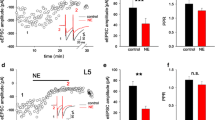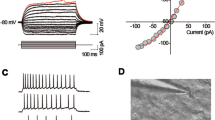Summary
The aim of the present study was to determine the local concentrations of noradrenaline existing at presynaptic α2-adrenoceptors during electrical pulse train stimulation of brain slices at different frequencies. The experiments are based on the assumption that the concentration of released noradrenaline at the α2-adrenoceptors exerting a certain autoinhibition should be equal to the concentration of exogenous noradrenaline causing the same inhibition under conditions in which any influence of the released transmitter is excluded. In order to avoid autoinhibition, hippocampus and cortex slices of the rabbit and the rat, prelabelled with [3H]noradrenaline and superfused in presence of an uptake inhibitor, were electrically stimulated using 4 pulses delivered at 100 Hz (POP stimulation). Exogenous noradrenaline diminished the overflow of tritium elicited by POP stimulation in a concentration-dependent manner. In rabbit brain tissues the EC50 value and maximum inhibition of noradrenaline release were found to be approximately 6 nmol/l and more than 95%, respectively, whereas in rat tissues the corresponding values were between 20 and 30 nmol/l and approximately 90%. When electrical stimulation was performed with trains of 36 pulses delivered at 0.1, 0.3 or 3 Hz in absence or presence of an uptake inhibitor, the α2-adrenoceptor antagonist yohimbine (1 or 10 μmol/l) enhanced the evoked tritium overflow in a manner which was dependent on the frequency of stimulation and on blockade of the re-uptake mechanism. The facilitatory effects of yohimbine reflected an extent of autoinhibition which was between 53% (36 pulses/0.1 Hz, no uptake inhibitor) and 85% (36 pulses/3 Hz, uptake inhibitor present) in rabbit and between 16% (36 pulses/0.3 Hz, no uptake inhibitor) and 71% (36 pulses/3 Hz, uptake inhibitor present) in rat brain slices. Accordingly, the corresponding estimated biophase concentrations of noradrenaline were generally higher in rat than in rabbit tissues (they were between 32.5 and 74.5 or 5.1 and 51.6 nmol/l in the presence or absence of an uptake inhibitor, respectively, in the rat, and between 15 and 23.1 or 6.1 and 18.6 nmol/l in the rabbit). The observed frequency dependence of the effect of re-uptake blockade on the calculated biophase concentrations of noradrenaline would be compatible with the idea of a dependence of the effectiveness of the re-uptake mechanism on the firing rate of the neurone in being more effective at lower frequencies. Moreover, the stikingly low biophase concentrations of noradrenaline suggest that also in brain tissue noradrenaline causes lateral inhibition of release as has recently been shown for guinea-pig vas deferens.
Similar content being viewed by others
References
Allgaier C, Jäger T, Hertting G (1989) Endogenous noradrenaline impairs the prostaglandin-induced inhibition of noradrenaline release. Naunyn-Schmiedeberg's Arch Pharmacol 340:472–474
Allgaier C, Hertting G, Singer EA (1991a) A detailed study on the effects of protein kinase C activation on α2-adrenoceptor-coupled modulation of norepinephrine release in hippocampus. J Pharmacol Exp Ther 258:143–148
Allgaier C, Greber R, Hertting G (1991b) Studies on the interaction between presynaptic α2-adrenoceptors and adenosine A1 receptors located on noradrenergic nerve terminals. Naunyn-Schmiedeberg's Arch Pharmacol 344:187–192
Baumann P, Koella WP (1980) Feedback control of noradrenaline release as a function of noradrenaline concentration in the synaptic cleft in cortical slices of the rat. Brain Res 189:437–448
Bevan JA (1977) Some functional consequences of variation in adrenergic synaptic cleft width and in nerve density and distribution. Fed Proc 36:2439–2443
Bevan JA, Su C (1974) Variation of intra- and perisynaptic adrenergic transmitter concentrations with width of synaptic cleft in vascular tissue. J Pharmacol Exp Ther 190:30–38
Brock JA, Cunnane TC (1990) Transmitter release from sympathetic nerve terminals on an impulse-by-impulse basis and presynaptic receptors. In: Kalsner S, Westfall TC (eds) Presynaptic receptors and the question of autoregulation of neurotransmitter release. Ann NY Acad Sci 604:176–187
Brock JA, Cunnane TC, Starke K, Wardell CF (1990) α2-Adrenoceptor-mediated autoinhibition of sympathetic transmitter release in guinea-pig vas deferens studied by intracellular and focal extracellular recording of junction potentials and currents. Naunyn-Schmiedeberg's Arch Pharmacol 342:45–52
Cejna M, Agneter E, Drobny H, Valenta B, Singer EA (1990) Pulse-to-pulse modulation of transmitter release in the central nervous system. Basic and pharmacological aspect. In: Kalsner S, Westfall TC (eds).Presynaptic receptors and the question of autoregulation of neurotransmitter release. Ann NY Acad Sci 604:211–221
Chesselet MF (1984) Presynaptic regulation of neurotransmitter release in the brain: Facts and hypothesis. Neuroscience 12:347–375
Heepe P, Starke K (1985) α Adrenoceptor antagonists and the release of noradrenaline in rabbit cerebral cortex slices: support for the α-autoreceptor hypothesis. Br J Pharmacol 84:147–155
Iversen LL, Jarrott B, Simmonds MA (1971) Differences in the uptake, storage and metabolism of (+)- and (−)-noradrenaline. Br J Pharmacol 43:845–855
Jackisch R, Werle R, Hertting G (1984) Identification of mechanisms involved in the modulation of release of noradrenaline in the hippocampus of the rabbit in vitro. Neuropharmacology 23:1363–1371
Kopin IJ, Zukowska-Grojec Z, Bayorh MA, Goldstein DS (1984) Estimation of intrasynaptic norepinephrine concentrations at vascular neuroeffector junctions in vivo. Naunyn-Schmiedeberg's Arch Pharmacol 325:298–305
Lattimer N, Rhodes KF (1985) A difference in the affinity of some selectice α2-adrenoceptor antagonists when compared on isolated vasa deferentia of rat and rabbit. Naunyn-Schmiedeberg's Arch Pharmacol 329:278–281
Limberger N, Mayer A, Zier G, Valenta B, Starke K, Singer EA (1989) Estimation of pA2 values at presynaptic α2-autoreceptor in rabbit and rat brain cortex in the absence of autoinhibition. Naunyn-Schmiedeberg's Arch Pharmacol 340:639–647
Mayer A, Limberger N, Starke K (1988) Transmitter release patterns of noradrenergic, dopaminergic and cholinergic axons in rabbit brain slices during short pulse trains, and the operation of presynaptic autoreceptors. Naunyn-Schmiedeberg's Arch Pharmacol 338:632–643
Middlemiss DN (1988) Receptor-mediated control of neurotransmitter release from brain slices or synaptosomes. Trends Pharmacol Sci 9:83–84
Orrego F, Miranda R (1977) Effects of tetrodotoxin, elevated calcium and calcium antagonists on electrically induced 3H-noradrenaline release from brain slices. Eur J Pharmacol 44:275–278
Parker RB, Waud DR (1971) Pharmacological estimation of drug-receptor dissociation constants. Statistical evaluation. I. Agonists. J Pharmacol Exp Ther 177:1–12
Reichenbacher D, Reimann W, Starke K (1982) α-Adrenoceptor-mediated inhibition of noradrenaline release in rabbit brain cortex slices. Receptor properties and role of the biophase concentration of noradrenaline. Naunyn-Schmiedeberg's Arch Pharmacol 319:71–77
Singer EA (1988) Transmitter release from brain slices elicited by single pulses: a powerful method to study presynaptic mechanisms. Trends Pharmacol Sci 9:274–276
Starke K (1979) Presynaptic regulation of release in the central nervous system. In: Paton DM (ed) The release of catecholamines from adrenergic neurons. Pergamon Press, Oxford, pp 143–183
Starke K, Göthert M, Kilbinger H (1989) Modulation of neurotransmitter release by presynaptic autoreceptors. Physiol Rev 69:864–989
Stjärne L (1975) Basic mechanisms and local feedback control of secretion of adrenergic and cholinergic neurotransmitters. In: Iversen LL, Iversen, SD, Snyder SH (eds) Handbook of psychopharmacology, vol 6. Plenum Press, New York, pp 179–233
Taube HD, Starke K, Borowski E (1977) Presynaptic receptor systems on the noradrenergic neurons of rat brain. Naunyn-Schmiedeberg's Arch Pharmacol 299:123–141
Valenta B, Drobny H, Singer EA (1988) Presynaptic autoinhibition of central noradrenaline release in vitro: operational characteristics and effects of drugs acting, at alpha-2 adrenoceptors in the presence of uptake inhibition. J Pharmacol Exp Ther 245:944–949
Williams J, Henderson G, North A (1984) Locus coeruleus neurons. In: Dingledine R (ed) Brain. Plenum Press, New York, pp 297–311
Zier G, Drobny H, Valenta B, Singer EA (1988) Evidence against a functional link between noradrenaline uptake mechanisms and presynaptic alpha-2 adrenoceptors. Naunyn-Schmiedeberg's Arch Pharmacol 337:118–121
Author information
Authors and Affiliations
Additional information
Send offprint requests to C. Allgaier at the above address
Rights and permissions
About this article
Cite this article
Allgaier, C., Agneter, E., Feuerstein, T.J. et al. Estimation of the biophase concentration of noradrenaline at presynaptic α2-adrenoceptors in brain slices. Naunyn-Schmiedeberg's Arch Pharmacol 345, 402–409 (1992). https://doi.org/10.1007/BF00176617
Received:
Accepted:
Issue Date:
DOI: https://doi.org/10.1007/BF00176617




